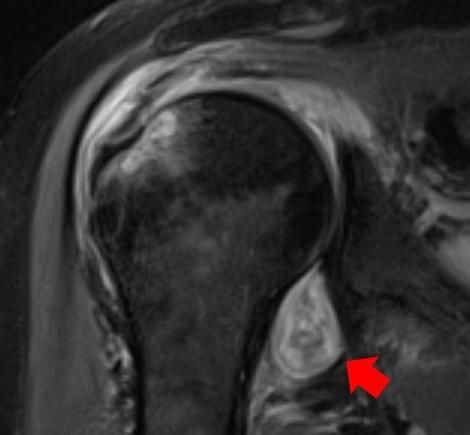Imaging Shows COVID-19 Creates a Body Self-Attack
CT, MRI, and ultrasound images reveal the myriad of ways the virus prompts the body to attack itself – with this knowledge, radiologists can better contribute to treatment planning.
Not only does COVID-19 attack the body, but radiology images show that the virus can actually make the body attack itself.
For some people, it can be as slight as sore muscles or achy joints. But, for others, the virus can actually kick-start worse symptoms, including rheumatoid arthritis flares, autoimmune myositis, or swollen and discolored toes, typically referred to as “COVID toes.”
The outward effects of these problems can be easily seen, but a team from Northwestern Medicine has pinpointed – and revealed via imaging – the causes of these symptoms. They published their findings on Feb. 17 in Skeletal Radiology.
MRI image of a patient's shoulder. The red arrow points to inflammation in the joint. The COVID virus triggered rheumatoid arthritis in this patient with prolonged shoulder pain after other COVID-19 symptoms resolved.
CREDIT
Northwestern University

“We’ve realized that the COVID virus can trigger the body to attack itself in different ways, which may lead to rheumatological issues that require lifelong management,” said corresponding author Swati Deshmukh, M.D., assistant professor of radiology at Northwestern University Feinburg School of Medicine. “Many patients with COVID-related musculoskeletal disorders recover, but for some individuals, their symptoms become serious, are deeply concerning to the patient or impact their quality of life, which leads them to seek medical attention and imaging.”
In a retrospective review of data from patients who presented to Northwestern Memorial Hospital between May 2020 and December 2020, Deshmukh’s team examined CT, MRI, and ultrasound studies for evidence that could point to why someone might have musculoskeletal symptoms that linger post-COVID.
Based on the team’s analysis of the studies, they saw instances where patients experience edema or inflammatory changes in tissues, as well as hematomas or gangrene. In addition, some images revealed bright, enlarged nerves, indicating injury, or blood clots.
Being able to see these details, she said, can help radiologists better direct patient care. By looking at the effects of the virus on a patient’s scans, the provider could help steer him or her to a rheumatologist or dermatologist for more extensive treatment. These studies could also help radiologists suggest a COVID-19 diagnosis in patients who previously were unaware they had contracted the virus.
Overall, she said, examining imaging studies can lead to better, more informed COVID-19-associated management. Radiologists can use this knowledge to potentially improve patient outcomes.
“I think it’s important to differentiate between what the virus causes directly and what it triggers the body to do,” she said. “It’s important for doctors to know what’s happening in order to treat correctly.”
For example, she said, if a radiologist knows COVID-19 can prompt a rheumatoid arthritis flare, he or she can send a patient who has joint inflammation visible on a MRI scan ordered for shoulder pain to a rheumatologist for further evaluation and possible treatment.
Ultimately, she said, the study walks through several types of musculoskeletal abnormalities, including visual examples, of what radiologists should look for. These results, she added, should alert imaging providers to the likelihood that pertinent findings are lurking in the images they interpret.
“Some doctors request imaging for patients with ‘COVID toes,’ for example, but there wasn’t any literature on imaging of foot and soft tissue complications of COVID,” Deshmukh said. “How do you find something if you’re unsure of what to look for?”
For more coverage based on industry expert insights and research, subscribe to the Diagnostic Imaging e-Newsletter here.
Meta-Analysis Shows Merits of AI with CTA Detection of Coronary Artery Stenosis and Calcified Plaque
April 16th 2025Artificial intelligence demonstrated higher AUC, sensitivity, and specificity than radiologists for detecting coronary artery stenosis > 50 percent on computed tomography angiography (CTA), according to a new 17-study meta-analysis.
New bpMRI Study Suggests AI Offers Comparable Results to Radiologists for PCa Detection
April 15th 2025Demonstrating no significant difference with radiologist detection of clinically significant prostate cancer (csPCa), a biparametric MRI-based AI model provided an 88.4 percent sensitivity rate in a recent study.